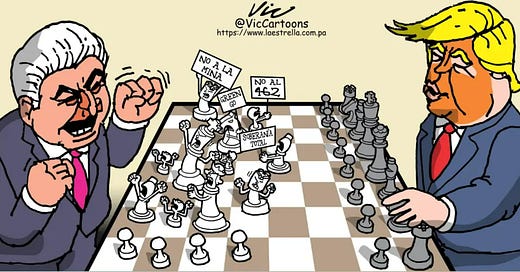Panama Protests and five other comments
Both Colombia and Peru have political soap operas distracting from real policy items.
Happy Thursday. I focus on US-LatAm relations on Mondays and then use the Thursday newsletter to highlight stories that aren’t directly about the US.
If you'd like to receive this sort of Latin America coverage in your inbox every Thursday, please pay to subscribe. It’s $90 per year for individuals or $350 per year for institutional subscribers.
In today’s newsletter:
Panama Protests
Colombia and China
Colombia’s security problems
Peru mining massacre
Water conflicts
Venezuela’s escaped politicians
Feel free to respond to this email with feedback, comments, and questions.
Panama has seen several weeks of protests, with Tuesday’s protests numbering in the thousands and shutting down key roads in the country. People are angry. It’s not just one issue. There is anger about the economy, Mulino’s deal with the US to allow US military personnel in the country, social security reform, the potential reopening of the Cobre Panama mine, and the ongoing perception of corruption in the country. I don’t think any one of these issues describes why the protesters are in the streets. Journalists who interview the protesters get different answers as they ask. People are angry, and the specific reasons any individual is in the street may be less important than the generalized anger that is causing them to come out as a group.
Businesses and foreign investors are concerned that this is becoming a repeat of 2023. They are right to be concerned. The 2023 protests, despite being labeled “anti-mining,” were mainly driven by the public’s anger at the corruption occurring under President Cortizo. It was generalized anger that was redirected at the mining agenda, but that made negotiations difficult because people’s anger wasn’t going to be placated by giving them new technical details related to mining agreements. Ultimately, the shutdown of the mine gave protesters a win, but the anger was still there, leading to an opposition victory in the 2024 elections. And the mine shutdown hurt the economy, which is part of why Mulino is now in this situation.
Mulino is now in a tough spot. Negotiating with protesters is tough when they don’t know what they want as a group. Yes, there are various unions and other social movements helping organize the protests for their own purposes. In particular, Suntracs, a local construction union, uses protests as a key part of its leverage. But to blame those groups misses the bigger picture. This is a variation of a chart I’ve used since 2019 for protests across Latin America, and definitely applies here:
How does Mulino escape this protest trap? It’s really not clear, and that is the concerning part. There may be solutions to get out of the current wave of protests. However, with four years left in his term, escaping the current protest moment simply kicks the can down the road for a few more months. The Trump administration could help him out, but one real fear is that the Trump administration will use Mulino’s weakness as a moment to take full advantage rather than a moment to help out someone who could be an ally.
This political cartoon from La Estrella that I first saw in Mat Youkee’s excellent newsletter on Panama sums up the problem quite well.
Colombian President Gustavo Petro plans to visit China, where he will sign an agreement to join Beijing’s Belt and Road Initiative. This past week, Petro’s government also signalled that they plan to join the BRICS financial structures and may attempt to apply to be a full BRICS member as the group meets in July in Brazil.
The precedent of Argentina’s Javier Milei shows why BRICS will keep Colombia at arm’s length, but Beijing will give Petro everything it can.
Keep reading with a 7-day free trial
Subscribe to Latin America Risk Report to keep reading this post and get 7 days of free access to the full post archives.






